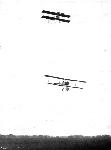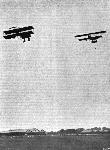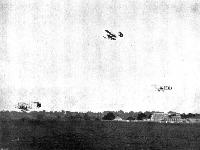P.Lewis British Aircraft 1809-1914 (Putnam)
Grahame-White Boxkite
The two-seat pusher Boxkite was built during 1912 for training, and, by virtue of its pair of rudders, was known as the "Bi-rudder Bus". It was employed extensively at Hendon in several modified versions. Tests were carried out on 27th November, 1913, with the firing of a Lewis machine-gun mounted on the machine. The Boxkite was flown by Marcus D. Manton, the gun being fired from the air at ground targets at Bisley, Hants. The engine was the 50 h.p. Gnome, and the machine was developed later into the Type 15 trainer used by the R.F.C. and the R.N.A.S, during the 1914-18 War.
Показать полностью
M.Goodall, A.Tagg British Aircraft before the Great War (Schiffer)
Deleted by request of (c)Schiffer Publishing
GRAHAME-WHITE Boxkite type biplanes
These Farman type biplanes, used from 1911 onwards for training purposes at Hendon, contained variations between individual machines. Most had a single rudder and were powered by a 50hp Gnome rotary engine. One early machine had been built at the end of 1910 to compete in the Baron de Forest Contest to be flown by Gresswell, but this was prevented by damage on the ground at Dover, in a gale. To qualify, it was fitted with a 60hp ENV type F eight-cylinder, water-cooled vee engine made at Willesden. After repair it flew at Hendon as School Biplane No.l, from 21 January 1911 until February, when a 60hp Wolseley was substituted, the ENV being reinstated in September 1911.
One of the school biplanes with 50hp Gnome was bought by the War Office in 1913, identified as serial No.309, and based at Farnborough.
GRAHAME-WHITE pusher type biplanes from 1912 leading to Type XV
In 1912-1913, a Boxkite with twin rudders, the bi-rudder 'bus, still with front elevator and exposed crew was used extensively at Hendon. On 27 November 1913, flown by Marcus D. Manton, it was used to demonstrate the use of a Lewis machine gun for firing at ground targets at Bisley. A similar machine to this, RNAS No. 1600, was supplied to the Admiralty early in 1915. This became the prototype for further batches, supplied in wartime to the RNAS and later to the RFC, to a total of 135 aircraft.
The early deliveries were fitted with a front elevator, which was discarded at some stage, and a nacelle for pilot and passenger, with full dual controls, was fitted. The top wings could be fitted with extensions, and the ailerons were fitted with balance cables. A variety of engines was fitted, including the 60hp Le Rhone, the 70 and 80hp Gnome air-cooled rotaries and the 60hp Green water-cooled type.
Despite the considerable differences between the early and later types, still being delivered in 1917, these aircraft were generally known as the Type XV.
Показать полностью
J.Bruce British Aeroplanes 1914-1918 (Putnam)
Grahame-White Type XV
THE Grahame-White Type XV was a development of the original Grahame-White Box-kite of 1912, and the designation Type XV seems in fact to have been applied to the Box-kite and its two derivatives. There are grounds for believing that one of the earlier forms of the aircraft may have been known as the Grahame-White Type XII, but the type number XV gained general application to all versions.
The original machine was typical of the box-kite form of aeroplane, and resembled the Farman biplane of 1909 which set a popular and widely-imitated style in aircraft design. Whereas the Farman and most other contemporary box-kite aeroplanes had only single-surface covering on the mainplanes, the Grahame-White biplane had double-surface covering.� The Grahame-White machine of 1912 had equal-span wings with four pairs of interplane struts on each side of the aircraft centre line. Ailerons were fitted to upper and lower wings, but were not laterally connected by balance cables. There were both forward and rear elevators. The tailplane was set high and, like the mainplanes, was square-cut. Two rudders were fitted, and earned the machine the nickname of “The Bi-rudder Bus”. The engine was the inevitable 50 h.p. Gnome, and the two occupants sat in complete exposure on a remarkably sketchy framework attached to the lower wing.
On November 27th, 1913, a Grahame-White Box-kite was the vehicle for an experiment which gave a foretaste of the fighting potentialities of aircraft. On that date, a Lewis machine-gun was fired from a Box-kite piloted by Marcus D. Manton; the gunner was Lieutenant Stellingwerf of the Belgian Army, who sat in a small seat mounted below and behind the pilot’s position. The air-firing tests were made at Bisley, and despite bumpy air Stellingwerf hit a ground target with 11 shots out of 25 on his first attempt, and with 15 out of 47 on his second.
The first form of the Grahame-White Box-kite saw service in some numbers, both at the Grahame-White flying school at Hendon before the war and with the R.N.A.S. after the outbreak of hostilities.
In 1914 and 1915 a slightly improved version of the design appeared. The basic airframe remained unchanged, but substantial, slightly tapered extensions were added to the upper wings, and balance cables connected the ailerons. A 60 h.p. Green engine was fitted, and much smaller tail-skids were used; these smaller skids were subsequently fitted to the original equal-span Box-kites. The extended Box-kite was used at the Grahame-White flying school early in the war. Among the distinguished aviators who learned to fly on the early Grahame-White Box-kite was Andre de Meulemeester, the celebrated Belgian fighter pilot.
<...>
Показать полностью
Журнал Flight
Flight, December 6, 1913.
THE LEWIS AIR-COOLED MACHINE GUN.
THE recent demonstration arranged by the Birmingham Small Arms Co., Ltd., at Bisley, in connection with the Lewis automatic air-cooled machine gun, at which a large number of distinguished naval and military officers and others interested in aviation were present, brings again into prominence the important part that will be played by aerial craft in a war between Powers provided with aeroplanes and dirigibles.
For the armament of such craft, the machine gun has inherent advantages over other weapons, but it is essential that the gun should be specially adapted for this class of work. It is important that it should be entirely self-contained, it should have little weight, be readily dismantled and assembled and be capable of firing in any direction; and since the time of engagement will probably be short, the projectile should be as destructive in its effects as possible. For use on aeroplanes, the weight, cumbrousness and recoil of a gun capable of discharging explosive projectiles render such at a disadvantage compared with the machine which is capable of firing a large quantity of small ammunition at high speed, and hence for this form of aircraft the latter is preferable.
It is claimed that in the Lewis air-cooled machine-gun, shown in the accompanying illustration, these qualities are exemplified. Its weight is 26 1/2 lbs., it can be handled by one man, and fired in any position or direction, its recoil is negligible and the normal rate of firing is 500 rounds per minute, but this can be increased if desired up to 800 rounds per minute, and single rounds, or bursts of any number of rounds up to the full capacity of the magazine, which is 47 rounds, may be fired if desired. The magazine, M, which takes under two minutes to load by hand and considerably less by the aid of a special machine, uses the ordinary service ammunition, and may be charged in a few seconds. The facility with which the assembling or dismantlement of the gun can be carried out is a remarkable feature of the invention, the only tool required being the nose of an ordinary bullet, and it is stated that 1,500 rounds may be fired without dangerously overheating the barrel, which is air-cooled. The system of air-cooling employed is not the least of its good points, as thereby the necessity of carrying a supply of water for cooling purposes is entirely avoided.
On the barrel, B, is a close-fitting sheath or jacket of aluminium with radiating longitudinal fins, surrounding which is a thin tubular steel casing, C, four inches in diameter. The tubular steel casing extends beyond the muzzle of the jacketted barrel, and as the gases of explosion emerge in a conical blast behind the bullet, they act as a kind of pump plunger inside this tubular extension, and suck currents of fresh cool air through the sector-shaped longitudinal passages along the exterior of the barrel. The air ejector thus formed at each discharge is most effective in cooling the barrel and is without mechanism or moving parts. During the first few hundred rounds the temperature rises rapidly until it has reached about 330° F., then more slowly until at the end of 1,000 rounds fired at full speed it does not exceed 440° F., and under ordinary Service conditions will be much lower.
The operating mechanism on the Lewis gun embodies several unique features, but one in particular should be mentioned - the use of a spring removed from the heat of the gun barrel. The gun is gas operated, that is to say, the energy required to load the breech and fire the cartridge is obtained by trapping some or the gases of the explosion through a small hole located a few inches from the muzzle. While the bullet is passing from this orifice to the muzzle, a period of about 1/9000th of a second, the gases deliver a blow to a piston, P, connected to the breech operating mechanism, and the energy thus stored as momentum in the moving mass serves to overcome the resistance represented by unlocking the breech, extracting and ejecting the cartridge case, turning the magazine and winding the spring that is subsequently to close the breech and fire the shot. This cycle of operations is repeated as many as 800 times a minute when the gun is working at its full speed, but the rapidity of fire can be regulated by changing the area of the orifice through which the gases are trapped, and by varying the tension on the clock-spring.
It is apparent that the spring element in such a system must be kept in perfect condition to function indefinitely, and particularly must it be kept from getting even moderately hot, for spring steel is permanently affected at 2700 F. A coiled spring lying along the stem of the piston is thus out of the question, and in the Lewis gun use is made of a "clock spring," S, of special and peculiar design, which is contained in a small oil- and dust-tight case of its own just in front of the trigger. The spring drum has a toothed periphery engaging with a toothed rack on the operating rod, R, and in this way the spring alternately controls and is controlled by the piston rod without being subjected to the temperature of the forward part of the rod itself.
To overcome the trouble often experienced through the jamming of the mechanism for feeding the cartridges, through derangement, a defect to which the belt form of feed is susceptible, or by the introduction of a little dust or sand, a balanced rotary magazine of circular form is employed, by means of which the cartridges and feeding mechanism are protected, and it becomes possible to fire the gun in any position. The cartridges are arranged radially as seen in the illustration, and are retained in a permanent circumferential position by flutes pressed on the outer casing of the magazine, and by slots in the interior, but the nose of the bullet rests in a coarse threaded ring clipped to the pivot about which the magazine turns. Thus as the magazine rotates, the cartridges are forced to descend along this groove until they pass into position for firing.
The construction adopted in order to reduce the recoil is another unique feature of this gun, and operates in the following manner. When the expanding gases emerge as a conical blast from the muzzle, they impinge with very high velocity against the inner surface of the tubular steel casing of the cooling system. For a distance of at least two inches the gases are in contact with the metal surface, and the friction thus set up is sufficient to diminish the recoil by more than one-half. In other words, the recoil of the Lewis machine gun is less than one-half that of any other machine gun of equal weight. It is, in fact, possible to fire the gun while holding it in the hands at arm's length, which is a very good test of its steadiness, and this quality, it need hardly be emphasised, is another advantage of first-class importance, particularly in respect to the use of armament on aircraft.
The tests to which the gun was subjected included firing from a Grahame-White biplane rigged up with an emergency seat below the pilot in flight, and from the 200 and 500 yards ranges at stationary targets. For the former, the target was about 25 ft. square, and from a height of between 400 and 500 ft., in a strong wind, Lieut. Stillingwerf of the Belgian Army scored 11 hits out of about 24 shots; and equally satisfactory results attended another attempt later in the afternoon, when a full magazine was discharged. At the 200 and 500 yards ranges some excellent work was done, and at the latter, out of 470 shots at full speed, more than 280 hits were found to have been made, during the subsequent examination of the targets.
In every respect, the claims made by the Birmingham Small Arms Co., Ltd., for the Lewis gun were well substantiated.
Flight, July 31, 1914.
EDDIES.
The ever-growing list of "professionals" who have made the jump from the slanting boards to the pilot's seat has received a new addition in Mr. Chas. Weber, of Budapest, who has taken his "ticket" recently at the Grahame-White School at Hendon. Mr. Weber, who is an acrobat by profession, and who has appeared on many of the London halls, has done a considerable amount of flying on various machines in Hungary during the last two years, and has had several rather exciting experiences. On one occasion when Mr. Weber was flying for his ticket on a monoplane fitted with an experimental engine, and was doing some very artistic figures of eight, the engine and the machine dissolved partnership. The return to earth was nothing like as graceful as had been the figures of eight; in fact, it was very decidedly a case of "boys cassy." Fortunately Mr. Weber was not seriously hurt, but his judgment got the better of his patriotism, and he decided to journey to this country to learn flying on a real aeroplane.
"AEOLUS."
Показать полностью

























